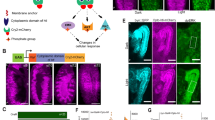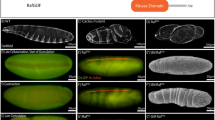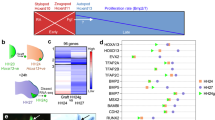Abstract
AFTER gastrulation, progenitor cells of the cardiac, visceral and body wall musculature arise at defined positions within the meso-dermal layer of the Drosophila embryo1–4. The regulatory mechanisms underlying this process of pattern formation are largely unknown, although ablation experiments carried out in other insects indicate that inductive influences from ectodermal cells have major roles in embryonic mesoderm differentiation5,6. An early and important event in the regional subdivision of the mesoderm is the restriction of tinman expression to dorsal mesodermal cells2,3. Genetic analysis has shown that this homeobox gene controls the formation of the visceral musculature and the heart from dorsal portions of the mesoderm3,7. We now show that an inductive signal from dorsal ectodermal cells is required for activation of tinman in the underlying mesoderm and present evidence that Decapenta-plegic (Dpp), a member of the transforming growth factor-β superfamily8, serves as a signalling molecule in this process. This demonstrates that the spatial expression of dpp in the ectoderm determines which cells of the mesoderm become competent to develop into visceral mesoderm and the heart.
This is a preview of subscription content, access via your institution
Access options
Subscribe to this journal
Receive 51 print issues and online access
$199.00 per year
only $3.90 per issue
Buy this article
- Purchase on SpringerLink
- Instant access to full article PDF
Prices may be subject to local taxes which are calculated during checkout
Similar content being viewed by others
References
Poulson, D. F. in The Biology of Drosophila (ed. Demerec, M.) 168–274 (Wiley, New York, 1950).
Bodmer, R., Jan, L. Y. & Jan, Y. N. Development 110, 661–669 (1990).
Azpiazu, N. & Frasch, M. Genes Dev. 7, 1325–1340 (1993).
Bate, M. in The Development of Drosophila melanogaster (eds Bate, M. & Martinez-Arias, A.) 1013–1090 (Cold Spring Harbor Laboratory Press, New York, 1993).
Seidel, F., Bock, E. & Krause, G. Naturwissenschaften 28, 433–446 (1940).
Haget, A. Bull. Biol. Fr. Belg. 87, 123–217 (1953).
Bodmer, R. Development 118, 719–729 (1993).
Padgett, R. W., St Johnston, R. D. & Gelbart, W. M. Nature 325, 81–84 (1987).
St Johnston, R. D. & Gelbart, W. M. EMBO J. 6, 2785–2791 (1987).
Immerglück, K., Lawrence, P. & Bienz, M. Cell 62, 261–268 (1990).
Panganiban, G. E. F., Reuter, R., Scott, M. P. & Hoffmann, F. M. Development 110, 1041–1050 (1990).
Wharton, K. A., Ray, R. P. & Gelbart, W. M. Development 117, 807–822 (1993).
Ferguson, E. L. & Anderson, K. V. Development 114, 583–597 (1992).
Brand, A. H. & Perrimon, N. Development 118, 401–415 (1993).
Anderson, M., Perkins, G., Chittick, P., Shrigley, R. & Johnson, W. Genes Dev. 9, 123–137 (1995).
Lints, T. J., Parsons, L. M., Hartley, L., Lyons, I. & Harvey, R. Development 119, 419–431 (1993).
Komuro, I. & Izumo, S. Proc. natn. Acad. Sci. U.S.A. 90, 8145–8149 (1993).
Tonissen, K., Drysdale, T., Lints, T., Harvey, R. & Krieg, P. Devl. Biol. 162, 325–328 (1994).
Smith, J. Development 99, 3–14 (1987).
Dale, L., Howes, G., Price, B. M. J. & Smith, J. C. Development 115, 573–585 (1992).
Jones, C. M., Lyons, K. M., Lapan, P. M., Wright, C. V. E. & Hogan, B. J. M. Development 115, 639–647 (1992).
Thomsen, G. H. & Melton, D. A. Cell 74, 433–441 (1993).
Logan, M. & Mohun, T. Development 118, 865–875 (1993).
Huang, J.-D., Schwyter, D. H., Shirokawa, J. M. & Courey, A. J. Genes Dev. 7, 694–704 (1993).
Frasch, M., Hoey, T., Rushlow, C., Doyle, H. J. & Levine, M. EMBO J. 6, 749–759 (1987).
Ip, Y. T., Kraut, R., Levine, M. & Rushlow, C. A. Cell 64, 439–446 (1991).
Hoch, M., Schröder, C., Seifert, E. & Jäckle, H. EMBO J. 9, 2587–2595 (1990).
Kirov, N., Zhelnin, L., Shah, J. & Rushlow, C. EMBO J. 12, 3193–3199 (1993).
Jiang, J., Cai, H., Zhou, Q. & Levine, M. EMBO J. 12, 3201–3209 (1993).
St Johnston, R. D. et al. Genes Dev. 4, 1114–1127 (1990).
Author information
Authors and Affiliations
Rights and permissions
About this article
Cite this article
Frasch, M. Induction of visceral and cardiac mesoderm by ectodermal Dpp in the early Drosophila embryo. Nature 374, 464–467 (1995). https://doi.org/10.1038/374464a0
Received:
Accepted:
Issue Date:
DOI: https://doi.org/10.1038/374464a0
This article is cited by
-
Excessive Dpp signaling induces cardial apoptosis through dTAK1 and dJNK during late embryogenesis of Drosophila
Journal of Biomedical Science (2011)
-
Cell cycle arrest by a gradient of Dpp signaling during Drosophila eye development
BMC Developmental Biology (2010)
-
Analysis of Thisbe and Pyramus functional domains reveals evidence for cleavage of Drosophila FGFs
BMC Developmental Biology (2010)
-
Genetic and Genomic Dissection of Cardiogenesis in the Drosophila Model
Pediatric Cardiology (2010)
-
Retinoic acid enhances skeletal muscle progenitor formation and bypasses inhibition by bone morphogenetic protein 4 but not dominant negative β-catenin
BMC Biology (2009)



